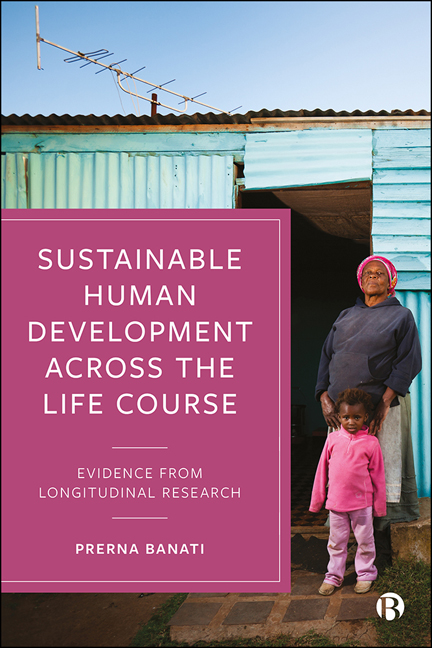Book contents
- Frontmatter
- Dedication
- Dedication
- Contents
- List of Figures, Tables and Boxes
- Notes on Contributors
- Foreword: Understanding and Enhancing Human Development Among Global Youth – On the Unique Value of Developmentally Oriented Longitudinal Research
- Introduction: Measuring Sustainable Human Development Across the Life Course
- 1 Exploring the Potential for Gender Norm Change in Adolescent Girls: Evidence from ‘Real Choices, Real Lives’ Longitudinal, Qualitative Study Data
- 2 Unequal Educational Trajectories: The Case of Ethiopia
- 3 Early Life Transitions Increase the Risk for HIV Infection: Using Latent Class Growth Models to Assess the Effect of Key Life Events on HIV Incidence Among Adolescent Girls in Rural South Africa
- 4 Achieving the Sustainable Development Goals: Evidence from the Longitudinal Parenting Across Cultures Project
- 5 Achieving Gender Equality: Understanding Gender Equality and Health Among Vulnerable Adolescents in the Sustainable Development Goals Era
- 6 Capturing the Complexities of Adolescent Transitions Through a Mixed Methods Longitudinal Research Design
- 7 Child Well-being Across the Life Course: What Do We Know, What Should We Know?
- 8 Mauritian Joint Child Health Project: A Multigenerational Family Study Emerging from a Prospective Birth Cohort Study: Initial Alcohol-related Outcomes in the Offspring Generation
- Conclusion: The Future of Longitudinal Research
- Index
Introduction: Measuring Sustainable Human Development Across the Life Course
Published online by Cambridge University Press: 05 January 2022
- Frontmatter
- Dedication
- Dedication
- Contents
- List of Figures, Tables and Boxes
- Notes on Contributors
- Foreword: Understanding and Enhancing Human Development Among Global Youth – On the Unique Value of Developmentally Oriented Longitudinal Research
- Introduction: Measuring Sustainable Human Development Across the Life Course
- 1 Exploring the Potential for Gender Norm Change in Adolescent Girls: Evidence from ‘Real Choices, Real Lives’ Longitudinal, Qualitative Study Data
- 2 Unequal Educational Trajectories: The Case of Ethiopia
- 3 Early Life Transitions Increase the Risk for HIV Infection: Using Latent Class Growth Models to Assess the Effect of Key Life Events on HIV Incidence Among Adolescent Girls in Rural South Africa
- 4 Achieving the Sustainable Development Goals: Evidence from the Longitudinal Parenting Across Cultures Project
- 5 Achieving Gender Equality: Understanding Gender Equality and Health Among Vulnerable Adolescents in the Sustainable Development Goals Era
- 6 Capturing the Complexities of Adolescent Transitions Through a Mixed Methods Longitudinal Research Design
- 7 Child Well-being Across the Life Course: What Do We Know, What Should We Know?
- 8 Mauritian Joint Child Health Project: A Multigenerational Family Study Emerging from a Prospective Birth Cohort Study: Initial Alcohol-related Outcomes in the Offspring Generation
- Conclusion: The Future of Longitudinal Research
- Index
Summary
The sustainable development challenge
In 2015, electrifying optimism surrounded the adoption of the Sustainable Development Goals (SDGs) as world leaders agreed to a 15-year deal to advance economic, social and environmental development globally, with a focus on those most left behind. The successor to the Millennium Development Goals (MDGs), the SDGs laid out in ‘The Road to Dignity by 2030: Ending Poverty, Transforming All Lives and Protecting the Planet’ (United Nations, 2015a) describes 17 ambitious goals, seen in Figure 0.1, that include: ending poverty and ensuring well-being for all ages, inclusive and equitable education, gender equality and empowerment, decent work and reducing inequality within and among countries (United Nations, 2015b). The global indicator framework, developed by the Inter-Agency and Expert Group on SDG Indicators (IAEG-SDGs), was agreed to at the 47th session of the UN Statistical Commission held in March 2016 and contains 230 indicators and 169 targets (United Nations, 2016).
At its heart, sustainable development is about families and communities living in peace and prosperity, their children growing up safe and healthy, and transitioning to productive adulthood. Chambers and Conway (1991, p 6) were perhaps the first to define sustainable livelihoods ‘which can cope with and recover from stress and shocks, maintain or enhance its capabilities and assets, and provide sustainable livelihood opportunities for the next generation; and which contributes net benefits to their livelihoods at the local and global levels and in the short and long term’.
Global goals such as the SDGs and the MDGs have undoubtedly driven sustainable development progress. Global averages have improved: children born today are less poor, and experience generally rising living standards, with many families living in better homes, and having access to consumer goods, and services such as electricity, water and sanitation and roads. Major improvements in health and education have been documented, with children born today less likely to be stunted and more likely to complete primary school than their counterparts born in 2000 (United Nations, 2015b).
Keeping in mind the lessons learned from the historical application of global goals (United Nations, 2015b), when looking forward, three key challenges beset the realization of the Sustainable Development agenda.
The first challenge is that progress has not been equitable – and inequalities are not adequately monitored and detected. Throughout the MDG period, advancements were uneven across regions, genders and age groups (Verma and Petersen, 2018).
- Type
- Chapter
- Information
- Sustainable Human Development across the Life CourseEvidence from Longitudinal Research, pp. 1 - 24Publisher: Bristol University PressPrint publication year: 2021



